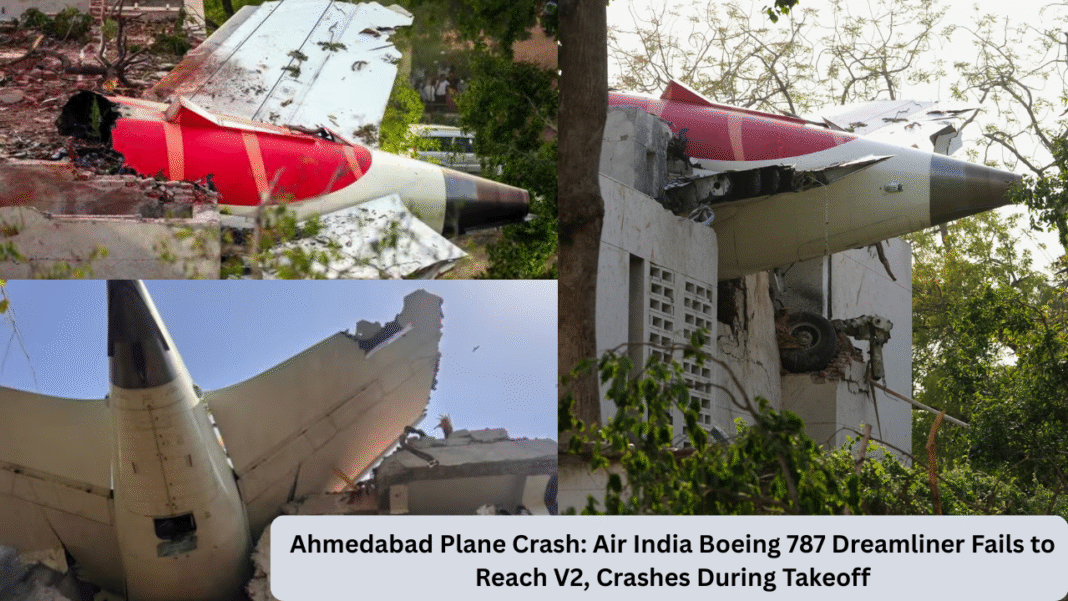What Happened in Ahmedabad?
The tragic plane crash in Ahmedabad involved an Air India Boeing 787 Dreamliner. Early investigations reveal that the aircraft failed to reach the V2 takeoff speed, a critical point in the takeoff sequence, and crashed shortly after leaving the ground.
V2 is the speed at which an aircraft gains enough lift to continue flying even if one engine fails. The aircraft reportedly stalled at just 600 feet altitude, far below the standard 2,000 feet safe altitude required for handling in-flight issues.
Understanding the Takeoff Process: What Went Wrong
During takeoff, the aircraft accelerates on the runway. Once more than half the runway is used, the co-pilot typically calls out “V1”, signaling a point of no return: brakes should not be applied because there’s not enough runway left to safely stop. The plane must take off.
However, reports suggest that after reaching V1, the Dreamliner never made it to V2. Despite reaching the rotation point, the aircraft stalled and plummeted shortly after liftoff.

Possible Causes of the Crash: Engine Failure or Stall?
1. Engine Failure?
Initial CCTV footage and eyewitness accounts indicate no bird strike—a usual suspect in such cases. There were no signs of black smoke from the engine, which typically appears during bird ingestion.
This rules out bird strike, raising suspicions of a mechanical failure, likely in the engines or control systems.
2. Angle of Attack and Stall
Another strong possibility is a stall caused by an excessive angle of attack. If a plane climbs beyond a critical angle—often over 15 degrees—the wings can no longer produce lift, and the aircraft starts to fall. Think of it like a bike tipping too far to one side—it’s no longer recoverable.
This scenario seems likely, especially since the aircraft reached only 600 feet before descending rapidly.
What Will the Black Box Reveal?
The black box, which is actually orange, is the key to unlocking the truth. It contains:
- Cockpit Voice Recorder (CVR): Records pilot conversations.
- Flight Data Recorder (FDR): Logs altitude, speed, engine status, fuel level, weight, and more.
Despite carrying 150,000 liters of fuel, the black box is designed to survive fire, water, and impact. It’s usually placed at the rear of the aircraft, which often remains somewhat intact during crashes.
Once retrieved, the black box report will offer a detailed timeline and help authorities confirm the actual cause—stall, engine failure, or both.
The Human Toll: Doctors Trapped Under Crash Site
Tragically, the aircraft crashed into a hospital building, where resident doctors were on their lunch break. Reports say that six to seven doctors were critically injured, and chances of survival were slim due to the fire and impact.
In aviation incidents, fatalities often occur not from the crash itself, but from the resulting fire. With 1.5 lakh liters of aviation fuel, this crash became a devastating inferno.
Critical Time Window: The First 4 Minutes
It’s well known in aviation that most crashes happen during the first 4 minutes of takeoff or the last 4 minutes of landing. The cruise phase is typically smooth—with minimal issues aside from light turbulence.
Speaking of turbulence, passengers have recently reported severe turbulence even at 37,000 feet, leading to injuries and onboard chaos—emphasizing the unpredictability of air travel.
Boeing Aircraft Reliability in Question Again
This crash adds to the growing concerns surrounding Boeing aircraft safety. Here’s a quick look at Boeing’s commercial models:
- Boeing 777 (Triple Seven): Highly reliable and used by leaders including Prime Minister Modi.
- Boeing 787 Dreamliner: The crashed aircraft model. Though advanced, it has had multiple reliability issues.
- Boeing 737 MAX: Infamous for back-to-back crashes. India had temporarily banned it after global incidents.
- Boeing 747: Used by the President of the United States, known for its durability.
Allegations of Cost-Cutting and Unsafe Practices at Boeing
Boeing’s quality control practices have come under intense scrutiny in recent years. In one case, a Boeing employee revealed that the oxygen delivery pipe on a Dreamliner was replaced with a second-hand part instead of a new one. Shockingly, that whistleblower was shot dead on the day of his court hearing.
Awaiting Black Box Report for Final Verdict
Until the black box from the Ahmedabad plane crash is analyzed, we cannot confirm the exact reason behind the crash. However, early signs point toward a combination of stall due to steep climb and possible engine malfunction.
This tragic incident once again raises serious questions about Boeing aircraft reliability, and highlights the critical nature of pilot decisions, aircraft maintenance, and manufacturer accountability.
Stay tuned for updates as the black box findings are released.




